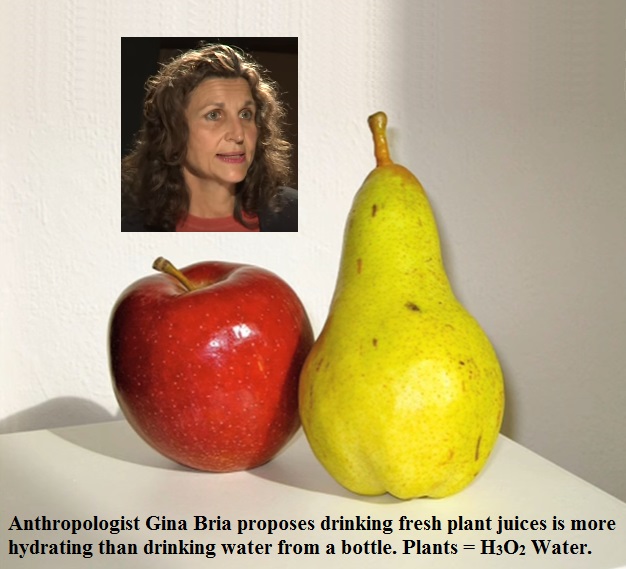TCM San Jiao Organ Produces the Same Gel-Form EZ Water Present in Fresh Fruits and Vegetables
How Does TCM San Jiao Organ Produce the Same Gel-Form EZ Water Present in Fresh Fruits and Vegetables?

San Jiao Organ Benefits from EZ Water Produced from Juicing
The San Jiao Organ is a very misunderstood and underappreciated organ in traditional Chinese medicine (TCM) and also in the west. My goal is to glorify the San Jiao ORGAN (aka Sanjiao, Triple Warmer, Triple Heater or Triple Energizer). As a consequence, I have written a book dedicated to substantiating that the San Jiao Organ is a guaranteed organ complex within the body. The book titled The ‘Mystical’ TCM Triple Energizer. Its Elusive Location and Morphology Defined (1) is exhaustive and full of information that authenticates the fact that ancient TCM sages fully comprehended the importance of water’s dynamic energetic capacity throughout the entire human body.
Contemporary scientific and medical research is confirming that the hydrolysis of water is the corner-stone of energy production all through the body, and that Adenosine Triphosphate (ATP) is subservient to the hydrolysis of water, in spite of bioscientists erroneously nominating ATP as the primary fuel source of the body. If you wish to know more about how the TCM San Jiao Organ energises water to produce EZ Water (H3O2), which causes “a transformation into biological and biochemical influences” throughout the entire body, this easy-reading scholastic book is perfect for you. The book can be securely purchased by clicking the ‘BUY NOW’ button at the bottom of this page.
Why Juicing is so Beneficial for Your Health
In the 2017 article titled ‘Water Supports Health in Ways You May Never Have Suspected’, Dr Joseph Mercola (2) includes a TEDx video featuring the anthropologist Gina Bria (3), who has studied desert-dwelling hydration techniques in detail. Her video is titled ‘How to Grow Water — It’s Not Only Blue, It’s Green’. The information gleaned has serendipitously helped her solve the problem of her aging mother’s chronic dehydration. Bria notes that dehydration is very common, citing that a 2 percent loss of body water leads to significant cognitive loss.
Bria (3) noted that a Harvard study revealed that more than half of American children are dehydrated, leading to a negative outcome for their health and academic performance. She reported that about 25 percent of children in the U.S. “do not even drink water on a daily basis”. In his article, Mercola (2) reported:
Bria was shocked to discover that desert people do not actually look for flowing water sources. Instead, they search for plants and roots. While the plants differ based on the region, the one thing these desert plants all have in common are that they are high-gel releasing plants, such as yucca and desert sage (chia seeds). These plants have adapted to the harsh environment of the desert, where water is scarce, and we can benefit greatly from their survival adaptations.
Bria (3) found that these types of plants “protect their roots and seeds with a gel-like water, H3O2 — the same substance Pollack dubbed EZ water”. Bria remarks that “H3O2 provides greater hydration with less volume of water.” It is indeed very ironic that our global human dehydration problems, due to water scarcity, may essentially be resolved by growing and consuming desert plants!
Essentially ALL plants contain from 80 to 90 percent of this EZ water. Subsequently, individuals “who struggle with dehydration may be better served by juicing leafy greens than drinking more tap water”. Bria (3) noted that drinking too much plain water can “flash flood” your system in as little as 10 minutes, causing the expulsion of valuable minerals in the process.
Bria notes, ‘The EZ water found in plants, on the other hand, releases the water more slowly, due to its gel form, allowing a slower yet more thorough hydration to occur. And, rather than flushing nutrients out, hydrating with plants provides you with a wide variety of nutrients, along with fiber that helps absorption’.
How did this knowledge help Bria solve her mother’s problem with chronic dehydration? Mercola’s article states, ‘She ground up fresh chia seeds and instructed the nursing staff to add some to her morning orange juice each day. This alone was enough to resolve her dehydration symptoms’.
Regarding consuming hydrated chia seeds, Bria stressed that when we ingest this denser form of water, we can hydrate more fully with less liquid being present. The water locked in the plants is able to enter our cells more efficiently that bulk water. She gives the ironic analogy of “growing water” using the desert plants that turn bulk water into gel-like EZ water. Subsequently she calls it “green water”. So drinking fresh plant juices and consuming fresh salad vegetables is more hydrating than drinking water from a bottle. Eating plants supplies us with water that is perfectly packaged with EZ water plus nutrients plus a matrix of fibre which further increases the absorption of water. Her formula is Plants = H3O2 Water.
How to Gauge Your Personal Daily Water Requirement
There’s no real science regarding the conventional wisdom suggesting you should drink eight 8-ounce glasses (1.9 litres) of water per day. Mercola (2) states, ‘Water requirements are in fact extremely individual and can vary from day to day, depending on your age, body size, activity level, temperature and so on.’ Mercola discussed three simple strategies to help you gauge your water requirement on any given day.
1 – Feelings of thirst. Mercola notes, ‘Once your body has lost between 1 and 2 percent of its total water content, it will signal its needs by making you feel thirsty’. He points out that the thirst reflex inclines to be underdeveloped in children and is generally compromised in older adults. It is known that by the time you actually feel thirsty, you are already dehydrated.
Recent research shows that a 2% dehydration level in an athlete causes a 10 percent decrease in athletic performance, and driving a vehicle while dehydrated ‘reduces your concentration and reaction time to the same degree as being legally drunk and/or sleep deprived.’
2 – The color of your urine. Mercola states, ‘You should be drinking enough water to turn your urine a light-colored yellow. Dark-colored urine is a sign that your kidneys are retaining fluids in order to maintain your bodily functions, which includes detoxification. As a result, your urine will seem highly concentrated and dark.’ He cautions that riboflavin (vitamin B2; found in most multivitamins) ‘will turn your urine a bright, almost fluorescent yellow, which will make judging your water requirement based on the color of your urine more difficult.’
3 – Frequency of urination. Mercola states, ‘A healthy person urinates on average about seven or eight times a day. If your urine is scant or if you haven’t urinated in several hours, you may need more water.’
What are the Best Ways to be Hydrated with EZ Water?
Thanks to nature, naturally structured, EZ-rich water is produced by natural gravity-fed springs. The EZ concentration of water can be increased through vortexing the water and/or by chilling the water before drinking it. Ice from a freezer is nearly all EZ water. As Gina Bria (3) noted above, drinking fresh green juice every day is a healthy way to optimise hydration. Frequent grounding or EarthingTM and getting a sensible dosage of healthy sunlight both help to build and optimize the EZ water content in your body.
REFERENCES:
(1) Gordon, L., The ‘Mystical’ TCM Triple Energizer. Its Elusive Location and Morphology Defined. Xlibris Press, Australia. 2016.
(2) Mercola, J., ‘Water Supports Health in Ways You May Never Have Suspected’. (Jan 2017). Available from <http://articles.mercola.com/sites/articles/archive/2017/01/28/ez-water.aspx?utm_source=dnl&utm_medium=email&utm_content=art1&utm_campaign=20170128Z3_NB&et_cid=DM134295&et_rid=1861671293>
(3) Bria, G., ‘How to Grow Water — It’s Not Only Blue, It’s Green’. (Nov 2016). Available from https://youtu.be/kAiCeRZLCoE?t=4
ACKNOWLEDGEMENT:
I wish to sincerely thank Dr Paul U. Unschuld for the selfless and tireless work he has committed to make many ancient Chinese medical classics available in English for study and research. My book is based predominantly around his scholarly work ‘Nan-Ching: The Classic of Difficult Issues’. I also wish to sincerely thank Professor Unschuld for permission to use citations of his translation in my book. His translation of ‘Nan-Ching: The Classic of Difficult Issues’ can be purchased from the following link: https://www.amazon.com/Nan-ching_The-Classic-Difficult-Comparative-Studies/dp/0520053729





